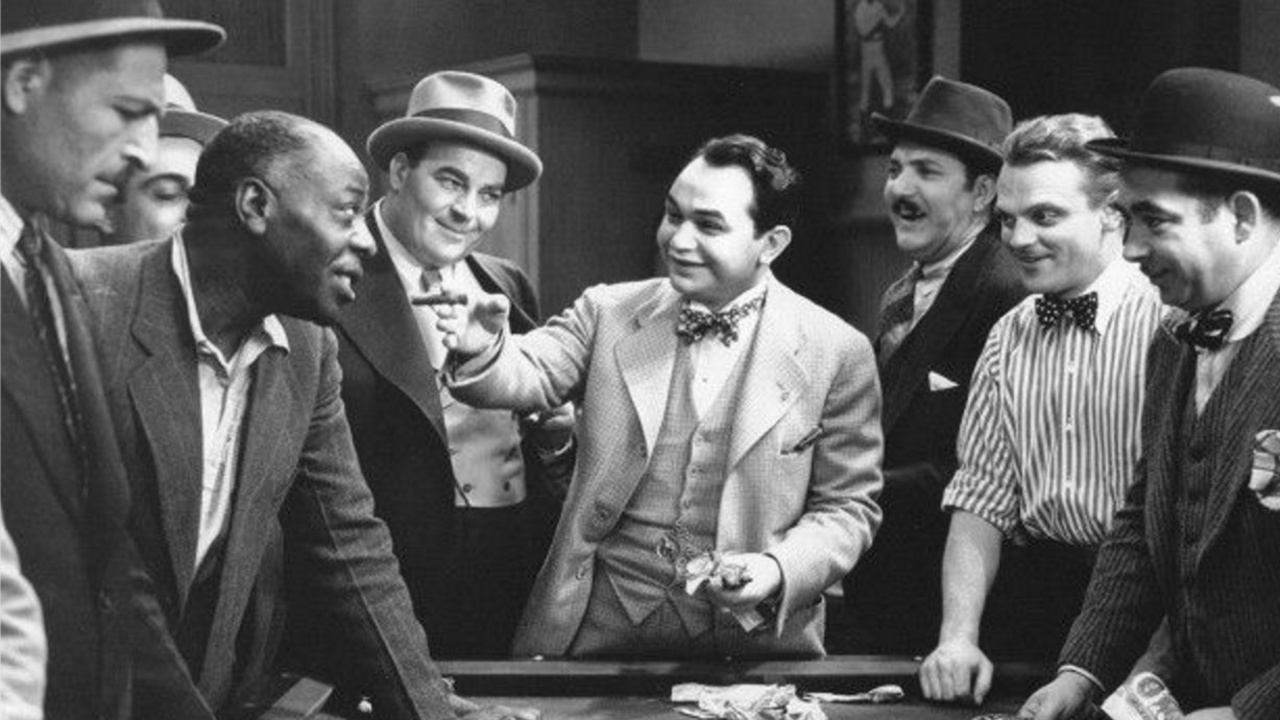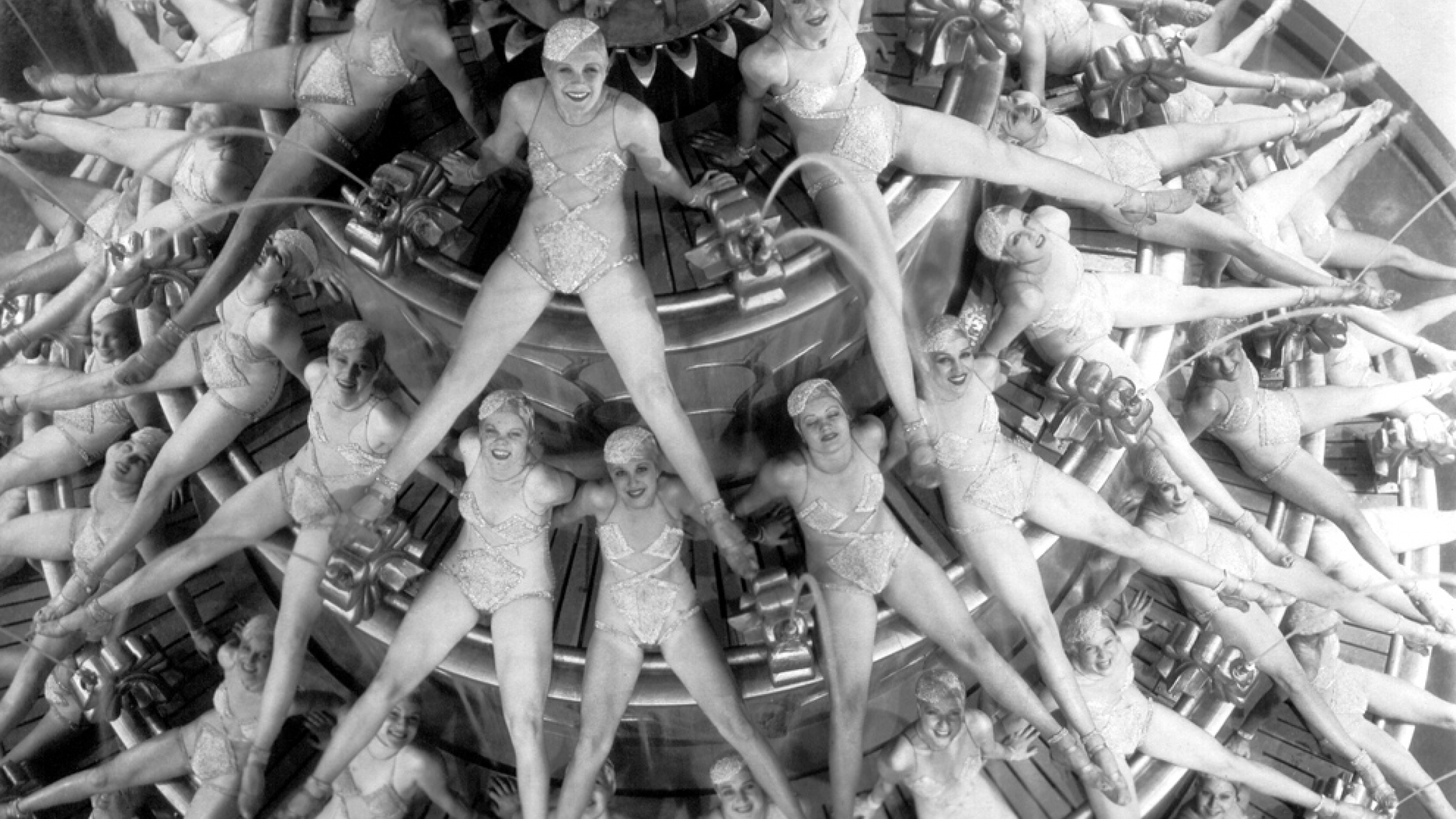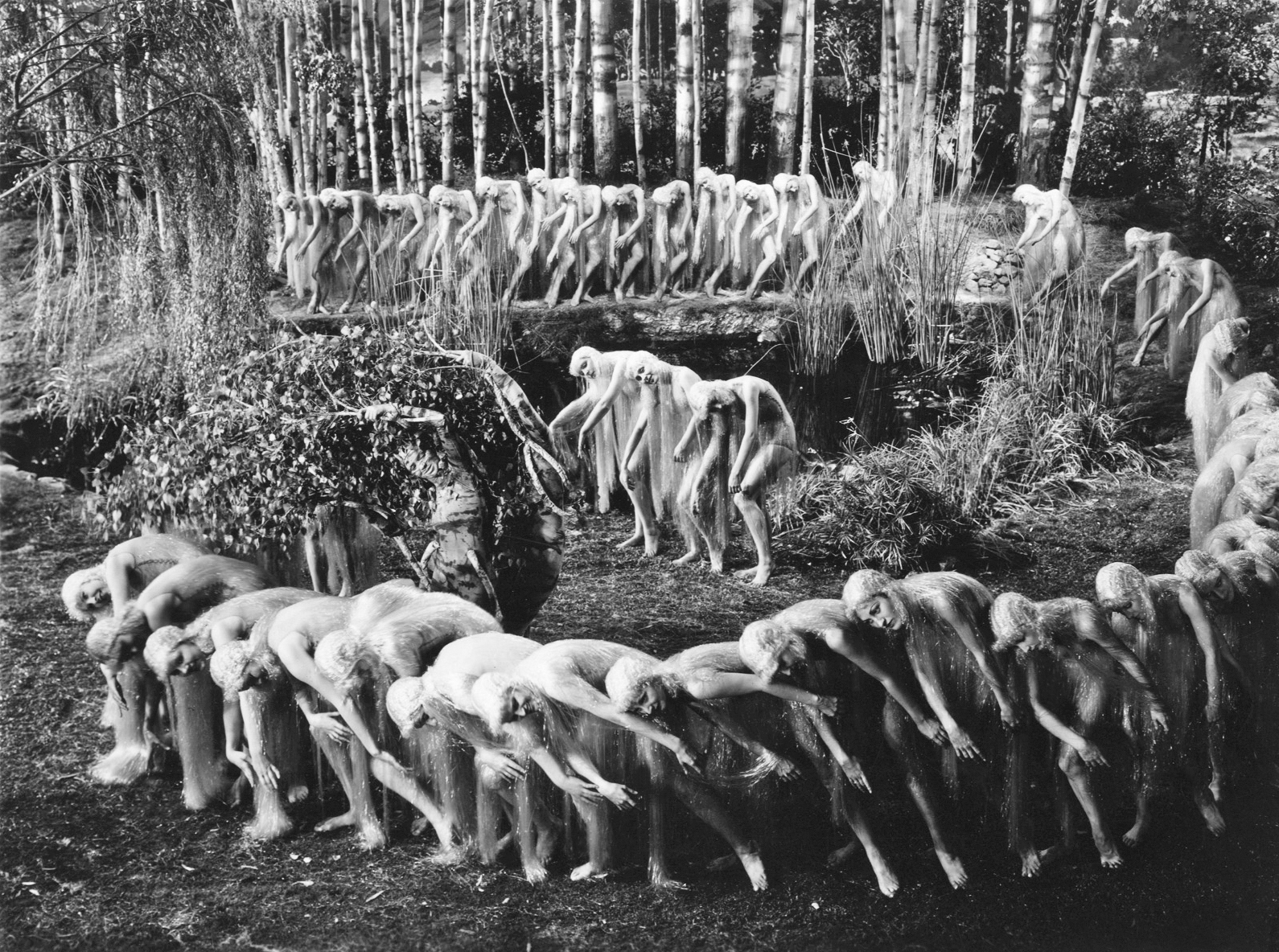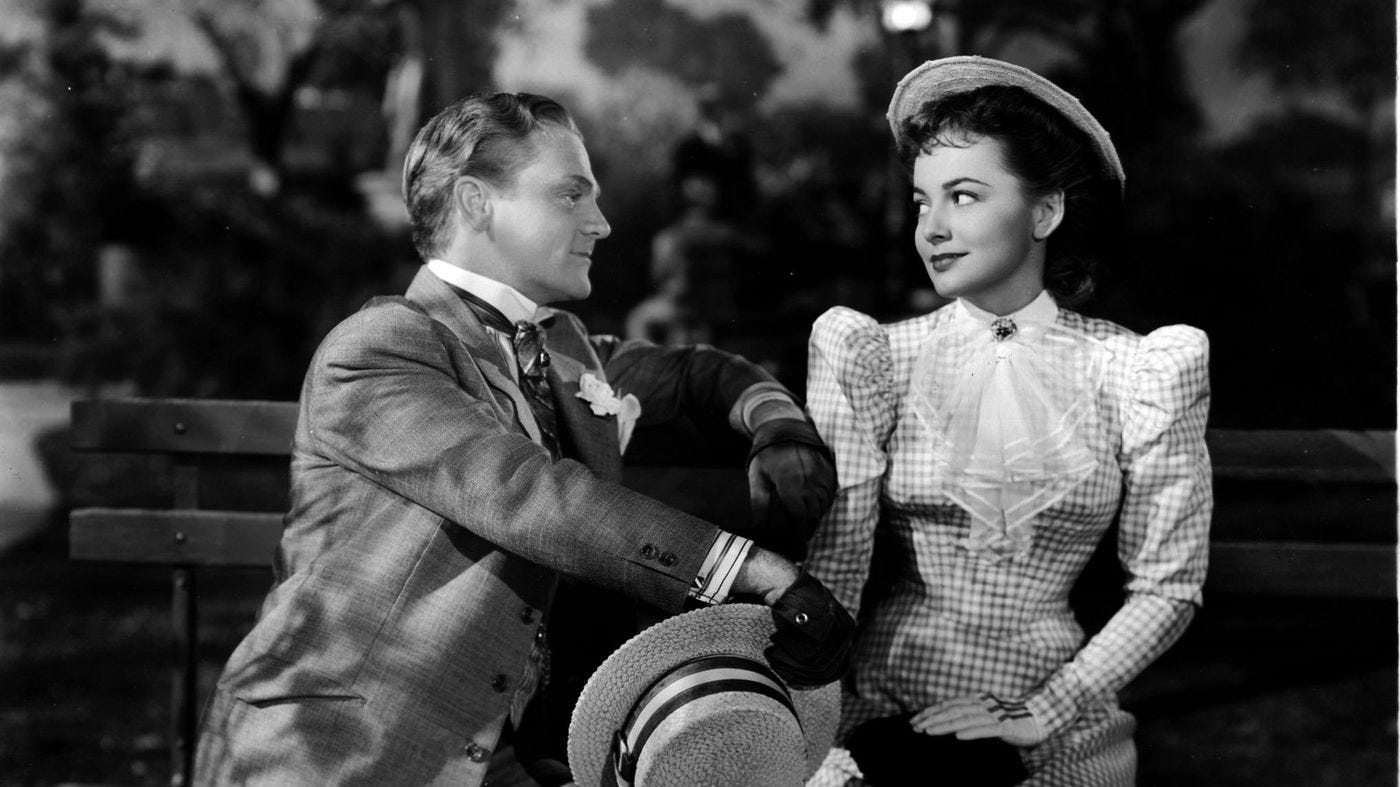Public Enemy: Cagney on Film
Programmed by: Tien-Tien L. Jong
Hoofer. Hoodlum. Hollywood icon. Stanley Kubrick and Marlon Brando both listed James Cagney as one of their favorite movie stars, and Orson Welles said he was “maybe the greatest actor to ever appear in front of a camera.” Will Rogers remarked, "Every time I see him work, it looks to me like a bunch of firecrackers going off all at once." Kenneth Tynan wrote, "Cagney, even with a submachine gun hot in hand and corpses piling at his ankles, can still persuade many people that it was not his fault." Cagney’s public image was of a Hollywood gangster who defined Warner Bros.' grit and made great, aggressive, dance-filled musical comedies at the same time.
As a performer, Cagney was more interested in the artistic possibilities of movement, as Patrick McGilligan argues in his book Cagney: The Actor as Auteur, noting, “Even when his pictures are not tightly edited, they seem paced at a blur, for Cagney is nearly always operating at an upper velocity, his movement swift and choppy, his words spilling out in a staccato rush.” Max Reinhardt also admired the way “every movement of his body, and his incredible hands” contributed to the reality of his characters. Cagney’s career very interestingly reflects (and surely even influenced) the trajectories of American history in the pivotal midcentury: its social consciousness in the wake of the Depression, its foreign wars, its paranoia, and its problematic patriotism. Otis Ferguson’s summation of Cagney was, “it is hard to say what our impression of the total American character would have been without him. He is all crust and speed and snap on the surface, a gutter-fighter with the grace of dancing. . . But underneath the fable: the quick generosity and hidden sweetness, the antifraud. . . In spite of writers, directors, and decency legions, you are going to see the world and what it does to its people through [Cagney's] subtle understanding of it.”
Blonde Crazy (1931)

Roy Del Ruth · 95m · DCP
Along with Public Enemy, this crime comedy launched Cagney, seemingly overnight, into Hollywood stardom. “In the pre-Code era, Cagney was more grifter than gangster,” in the words of Erik Lundegaard, and Blonde Crazy is “a tale told in four or five grifts.” Cagney teams up with Joan Blondell as a smart-talking bellhop and chambermaid duo to con their way to fortune in this scheming tale of romance and deception. Keep your ears open for Cagney’s iconic line: “That dirty, double-crossin’ rat!"
Thursday, June 20th 8:00PM · Friday, June 21th 5:00PM
Yankee Doodle Dandy (1942)

Michael Curtiz · 126m · 35mm
Following his self-defense before HUAC in Aug. 1940, Cagney was told by his brother William, “We’re going to have to make the goddamndest patriotic picture that’s ever been made.” The resulting biopic about George M. Cohan is, despite Cagney’s initial disinterest, a special moment in his career. Cagney was maybe never better, and his acting extends to his dancing here—a precise imitation of Cohan’s stiff-legged style. After seeing Cagney play him, Cohen exclaimed, “My God, what an act to follow!”
Thursday, June 27th 8:00PM · Friday, June 28th 5:00PM
Smart Money (1931)

Alfred E. Green · 81m · 35mm
Remembered for being the only time Cagney and Edward G. Robinson would make a movie together –– despite being Warner Bros.’s two biggest stars —Smart Money is one of the earliest high-stakes poker movies of the sound era (and Boris Karloff is also here, for 2 minutes!). Cagney and Robinson play off each other dynamically, including in a wonderfully wordless conversation they have about who is at the door, using only facial expressions and hand gestures.
Wednesday, July 3rd 8:00PM · Friday, July 5th 5:00PM
Footlight Parade (1933)

Lloyd Bacon · 104m · 35mm
Seeking an escape from the gangster roles Warner Bros. had typecast him in, Cagney proved his versatility and vaudeville roots in this outlandish musical spectacle. Cagney shines as the imaginative, always hustling director of a musical revue, scrambling to stay relevant against the cultural hegemony of “talking pictures” (with more than a little irony). Busby Berkeley’s opulent set pieces include 300 choreographed swimmers, a human waterfall, opium dens, and Cagney’s virtuosic dancing debut.
Thursday, July 11th 8:00PM · Friday, July 12th 5:00PM
A Midsummer Night's Dream (1935)

William Dieterle, Max Reinhardt · 143m · 35mm
Otherworldly and strangely out of its time, this gauzy adaptation is “such stuff as dreams are made on” — (Kenneth Anger hallucinated getting his start in movies as the child actor playing the Changeling Prince.) For Bottom, the theater troupe’s braggart who becomes a literal ass, Reinhardt insisted on casting Cagney, saying, “Few artists have ever had his intensity, his dramatic drive. Every movement of his body, and his incredible hands, contribute to the story he is trying to tell.”
Thursday, July 18th 8:00PM · Friday, July 19th 5:00PM
Angels with Dirty Faces (1938)

Michael Curtiz · 97m · DCP
Returning to Hell’s Kitchen after serving time for armed robbery, charismatic gangster Rocky Sullivan (Cagney) quickly becomes a local antihero to the neighborhood’s street kids, while his old friend Father Connolly (Pat O’Brien) tries to keep them all on the straight and narrow. Cagney drew on his experiences growing up in New York slums for the role; Rocky’s twitchiness and catchphrase “Whadda ya hear! Whadda ya say!” were inspired by a drug-addicted pimp he remembered from childhood.
Thursday, July 25th 8:30PM · Friday, July 26th 5:00PM
The Roaring Twenties (1939)

Raoul Walsh · 107m · 35mm
Spanning over a decade from WWI and Armistice through Prohibition and Repeal and concluding with the aftermath of Black Friday on skid row, Cagney and Humphrey Bogart star as two WWI vets turned bootleggers—and eventual rivals. Amplifying themes of betrayed loyalties and urban corruption from Angels with Dirty Faces and Public Enemy, this sprawling portrait of the dazzling and dangerous Jazz Age is the most historically insightful and beautiful of Cagney’s four major gangster films.
Thursday, August 1st 8:00PM · Friday, August 2nd 5:00PM
The Strawberry Blonde (1941)

Raoul Walsh · 97m · DCP
Rita Hayworth plays the elusive, strawberry blonde society girl Virginia to Cagney’s small-town dentist Biff and Olivia de Havilland’s suffragette Amy in this very charming musical comedy. A part of the cycle of nostalgic Belle Epoch films made in Hollywood during WWII (along with Magnificent Ambersons and Meet Me in St. Louis), the gentle, humorous misunderstandings of a romcom marked an appealing change of pace for Cagney, who had just been accused of being a Communist sympathizer by the House Un-American Activities Committee.
Thursday, August 8th 8:00PM · Friday, August 9th 5:00PM
White Heat (1949)

Raoul Walsh · 114m · 35mm
“Made it, Ma! Top of the world!” This absorbing noir-ish thriller, which marked Cagney’s return to both Warner Bros. and the gangster genre after a stint in independent films, showcases the actor in his most sadistic and strange role. White Heat cleverly reworks many of Cagney’s famous themes from previous WB gangster roles. As Cody Jarrett, the psychotically violent leader of a train robbery (with a disturbingly close attachment to his “Ma”), Cagney is electric, especially in the film’s chaotic finale.






